Looking for a NOC partner? You just found it.
.png?width=1273&height=450&name=imageonline-co-roundcorner%20(1).png)
Our award-winning outsourced NOC support services provide exactly the level of support you need—when you need it. Focus your attention and resources on revenue-generating projects and leave infrastructure monitoring and management to us. Our NOC can rapidly respond to incidents and events and continue to implement changes as needed, all under a more cost-effective service model.
Choosing a Network Operations Center (NOC) provider is one of those decisions that might look simple on paper but can quietly make or break your IT operations. We've seen too many organizations get burned by picking the wrong partner, ending up with escalating costs, finger-pointing during outages, and support teams that mysteriously vanish when things get complicated.
This guide finally spells out what actually matters when you're evaluating NOC providers in 2025. Not the marketing fluff, but the real questions that separate competent partners from disasters waiting to happen.
What a Modern NOC Actually Does (Beyond “Watching Screens”)
Before we jump in, let's level-set on the actual function of a NOC today.
A mature NOC is the operational nerve center that ingests telemetry from diverse monitoring sources, correlates events, prioritizes by business impact, initiates or enriches incident tickets, drives troubleshooting workflows across multiple technical tiers, and feeds data back into problem, change, and capacity management.
Here at INOC, our Ops 3.0 platform exemplifies this full life-cycle motion—auto-correlating alarms from many inputs into a single actionable ticket view that improves speed and accuracy while reducing human delay:
Most high‑performing NOCs also operate in tiered fashion aligned to ITIL processes, with clear escalation paths, automation to handle volume, and documentation to sustain consistency across shifts.
Below we walk through each dimension of evaluating a NOC service provider, unpack what “good” looks like, add internal alignment questions, and show how to score providers.
1. Onshore vs. Offshore Support and Data Sovereignty
Location affects more than language—it drives staff stability, institutional knowledge retention, regulatory alignment, background screening rigor, and where your data ultimately resides.
We've observed (anecdotally) that offshore teams often suffer high turnover (40–50%) and that some providers misrepresent offshored operations as U.S.‑based—risking compliance violations and degraded service quality.
Here at INOC, we're fully U.S.-based first (with global options) and see a way longer turnover period (~9–10 years) plus rigorous seven‑year background checks—key signals of workforce stability and trust, especially for regulated or defense supply‑chain environments that require data to remain onshore.
Consider the following questions internally:
-
Which jurisdictions can (or must) host our data? Any data residency mandates?
-
Are export controls, ITAR, or similar restrictions in scope?
-
What language, cultural, or time‑zone alignment do our internal teams require for collaboration?
-
What is our risk tolerance for staff churn in our support partner?
Questions for providers
|
2. Security Framework and Controls
Your NOC provider becomes an extension of your operational security surface. Weak segmentation, lax access governance, or light auditing can materially expand a breach blast radius. We strongly recommend that teams look beyond logo-driven certification checkboxes to the rigor of the audit (who certified, where, and how deep), multi-tenant isolation, and ongoing background checks & training—especially with remote staff.
We received our ISO 27001:2022 certification through accredited auditor A‑Lign, and have supporting controls (background checks, SOC 2 Type II data centers, physical facility access, client separation, and compliance mappings like NERC CIP, Privacy Shield, CAS(T)).
A few things we recommend doing internally here:
-
Map which of your compliance regimes (e.g., ISO, SOC 2, HIPAA, PCI, NERC CIP, ITAR) extend to the NOC.
-
Identify the privileged credentials that the NOC will hold; determine the least-privilege and rotation requirements.
-
Define evidence artifacts you’ll need during audits (access logs, change records, incident reports).
Questions for providers
|
3. Operational Capability and Framework
A NOC partner's operational maturity—tiered support, robust knowledge management, and continuous improvement—separates high‑performing NOCs from the typical one: pretty dashboards and unhappy customers. Effective NOCs follow ITIL/FCAPS, have and optimize a Tier 1 team, and hit 65–80% first‑level resolution with clear escalation and problem management loops.
At INOC, we have a structured operating model that reduces high-tier workload by 60–90% by optimizing incidents by tier, backed by an upstream Advanced Incident Management (AIM) team that front-loads troubleshooting and drives 65–80% first-touch resolution results.

Read our best practices guide for a more in-depth look at this.
Consider the following questions here:
-
What percent of today’s events are resolved at first touch? What’s the target you'd like to hit?
-
Do we have written escalation matrices per technology and severity?
-
Are problem, change, and capacity processes linked to incident analytics?
-
How current are our runbooks? Who owns them?
Questions for providers
|
4. Automation and AI Capabilities
Alert volume already exceeds human scale in most environments—especially in the enterprise. Automation and machine learning are now table stakes for noise reduction, enrichment, and pre‑emptive remediation.
We see real outcome deltas here with our AIOps engine—26% faster time‑to‑ticket & 50% faster resolution (Adtran); 900% MTTR improvement (a major financial services provider); 20% ticket‑volume cut (Aqua Comms)—showing that properly implemented AI and automation moves business metrics, not just tool adoption checkboxes.
AIOps vendors report similar benefits:
- BigPanda cites GenAI‑assisted prioritization, automated routing, and up to 50% MTTR reduction when incident data from many monitoring tools is consolidated into a unified console.
-
Reducing MTTR also yields outsized economic returns. ScienceLogic references industry research pegging unplanned downtime in the $5,600–$9,000 per‑minute range—underscoring the ROI potential when AIOps shortens outages.
Our Ops 3.0 platform serves as an operational "OS" for our NOC, ingesting multi-source alarms, auto-correlating them into unified tickets, and accelerating incident, problem, and capacity workflows while freeing engineers from low-value runbook toil.
Here's how it works:
The INOC Ops 3.0 Platform
|
For a quick automation readiness checklist on these points:
-
Inventory your current monitoring feeds (volume, fidelity, duplication).
-
Identify the top 10 noisy alerts suitable for auto‑suppression/correlation.
-
Document low‑risk, repetitive remediation candidates for automation.
Questions for providers
|
5. Call Flow, Incident Intake and Time to Impact Assessment (TTIA)
The first 5–15 minutes of an event significantly impact everything that happens downstream in terms of speed and quality. If Tier 1 generalists simply re‑route tickets, you lose context, double‑handle work, and inflate MTTR.
That's why we insert senior NOC engineers at the front of the intake stream to perform initial investigation, craft an action plan, and prevent misrouted tickets—one driver of faster resolution.
We also measure metrics beyond simple acknowledge time, including TTIA (how fast business impact is understood) and Time to Action—helpful leading indicators you can bake into SLOs.
For years now, the best practice has been to maintain clear escalation paths and run priority‑based incident handling so critical problems that stagnate >30 minutes are force‑escalated—evidence that disciplined intake remains a universal success factor.
Ask yourself:
-
Where does contextual enrichment happen today? Before or after ticket creation?
-
What percentage of the highest-priority incidents are correctly categorized as open?
-
What's our average time from alarm to actionable diagnosis?
-
Do we track TTIA now? If not, what data elements are missing?
Questions for providers
|
6. Pricing Structure, Value, and Total Cost of Ownership (TCO)
When thinking about ITSM services like NOC support, sticker price hides lifecycle economics: staffing 24×7 shifts, tooling licenses, platform maintenance, training, facilities redundancy, and attrition costs.
We always underscore our transparency, predictability, alignment with activity levels, and contractual year-over-year cost reductions as our improvements in efficeienyt get paid back as dividedneds to customers. Teams that consider standing up a NOC commonly realize a 50% TCO savings working with us compared to building an in-house solution.
Most organizations we work with are surprised by the true in‑house cost curve, multi‑month build timelines, and the economic leverage of inheriting an established outsourced platform. More on that in our in-house vs. outsource explainer.
If you're really thinking about building a NOC yourself:
-
Model the 3-year blended cost including staffing bands, benefits, coverage ratios, and turnover backfill.
-
Include platform/tool licensing (monitoring, ITSM, AIOps, analytics), maintenance, and upgrade cycles.
-
Try to quantify the cost of missed SLAs or downtime using revenue/hour or cost/minute metrics. Spoiler: you likely won't like what you see here.
Questions for providers
|
7. Service Level Management That Actually Matters
Providers can (and often do) “game” simplistic SLAs (e.g., 5‑minute acknowledge) without delivering meaningful outcomes. High compliance percentages can mask poor service if metrics ignore quality, categorization tricks, or repeated escalations back to your team. If you're being told things are great when they feel not-great, there's likely some deception going on—subtle or otherwise.
That's why we always recommend measuring a richer slate of SLOs—TTIA, actionable notification times, update cadence, MTTR—and granular breakdowns by responsible party.
You should demand transparency and metrics that actually tell you something useful about your network performance. We're often the provider teams turn to when they're tired of getting rosy reports from their NOC providers, despite not being happy with the performance.
A few very important questions here:
-
Which metrics most closely tie to business risk (e.g., TTIA for trading floor latency; MTTR for retail POS)?
-
Where do we need granularity (tech stack, site, customer segment)?
-
Do we require responsibility attribution (our team vs. provider vs. third party)?
Questions for providers
|
8. CMDB and Knowledge Management
Alerting without a trusted configuration context produces noise—especially in the modern IT environment. A robust CMDB is the “glue” of NOC operations, accelerating diagnosis, enabling impact assessment, standardizing repeat fixes, and supporting dependency-based root-cause analysis.
Read our full guide on it here.
Our CMDB extends well beyond device inventory to include knowledge articles, third‑party contacts, circuit data, customer/service mappings, alarm metadata, and more. This is rich data that feeds AIOps correlation and equips engineers with actionable insight.
Ask yourself:
-
What percentage of our monitored assets are represented as CIs with current attributes?
-
Do we maintain service topology relationships (upstream/downstream impact)?
-
Are vendor and carrier contact details linked to CIs for rapid engagement?
-
How often are knowledge articles reviewed/retired?
Questions for providers
|
9. Reporting and Analytics
Data-rich reporting drives continuous improvement, capacity planning, and vendor accountability. We provide our clients with real-time dashboards, incident responsibility attribution (INOC vs. client vs. third-party), trend analysis, capacity insights, and service reporting/analysis teams that align outputs to changing business needs.
Our NOC service integrates customizable dashboards, embedded reports, and responsibility tracking so decision‑makers can pinpoint where resolution delays occur across the support ecosystem.
Ask yourself:
-
Which stakeholders consume NOC data (Ops, Execs, Finance, Customers)?
-
What reporting cadence (real‑time, daily, monthly, QBR) do they need?
-
Which cuts matter (by service, tech, geography, vendor, responsibility)?
-
Do we need an API export for BI tools?
Questions for providers
|
10. Tool Integration and Flexibility
Ripping and replacing your existing monitoring or ITSM stack just to fit a provider often kills ROI and extends onboarding—not to mention making everyone angry. Evaluate the breadth of a provider's supported tools, flexibility for custom environments, and willingness to adapt to your stack, not force theirs.
We offer broad NMS support (SolarWinds, LogicMonitor, New Relic, Nagios, OpenNMS, Dynatrace), bidirectional ticketing, comms integrations, and custom monitoring development—all hallmarks of a mature integration practice in 2025. And because our Ops 3.0 platform consolidates diverse alarm feeds into a single correlated ticket pane, integration depth also feeds automation quality and incident prioritization.
In short, our clients keep the tech stacks they know and (maybe) love while inheriting our AIOps-enabled NOC capabilities.
A few steps here to consider first:
-
Inventory your current monitoring, observability, ITSM, and comms tools (list versions and API maturity).
-
Identify which tools are mandated vs. replaceable.
-
Map integration data flows (event in, ticket out, enrichment lookups, status sync).
-
Define any security and access constraints for cross‑tool connections.
Questions for providers
|
Putting It All Together: A Scoring and Shortlist Framework
Below is a lightweight scoring model you can tailor in Excel or your sourcing platform. Weight each dimension according to business priority; score vendors 1–5. Add multiplier for cultural fit / references if desired.
| Dimension | Weight | Vendor A | Vendor B | Vendor C | Notes |
|---|---|---|---|---|---|
| Onshore/Data Sovereignty | 10 | ||||
| Security & Compliance | 15 | ||||
| Operational Maturity | 15 | ||||
| Automation & AIOps | 10 | ||||
| Intake & TTIA | 10 | ||||
| Pricing/TCO | 15 | ||||
| Service Levels | 10 | ||||
| CMDB/Knowledge | 5 | ||||
| Reporting/Analytics | 5 | ||||
| Tool Integration | 5 | ||||
| Total | 100 |
(Adjust weights to match risk profile—e.g., Regulated industries may push Security to 25%.)
A Quick Red‑Flag ChecklistUse this during early vendor calls to decide who advances.
|
Want to learn more about our approach to outsourced NOC support? Contact us to see how we can help you improve your IT service strategy and NOC support, schedule a free NOC consultation with our Solutions Engineers, or download our free white paper below.
Frequently Asked Questions
NOC as a Service refers to the outsourcing of Network Operations Center (NOC) functions to a third-party provider who handles the setup, management, and operationalization of your NOC. This can include everything from event monitoring and incident management to advanced support levels, allowing businesses to focus on core functions without the complexity of running an in-house NOC.
Businesses often outsource NOC support to alleviate the high costs and complexities of managing a NOC in-house. Outsourcing allows access to specialized expertise, reduces operational costs, and frees up internal resources to focus on revenue-generating activities. This setup ensures that networks, infrastructure, and applications are managed effectively without the burden of maintaining a full-time, in-house NOC team.
INOC's NOCaaS includes a range of services such as:
- Event Monitoring and Management
- Incident and Problem Management
- Notification Support
- Tier 1 and Advanced Tier 2 & 3 Support
- Capacity and Change Management
- Service Transition and Planning
- On-Demand NOC Support
- Service Reporting and Analysis
These services ensure comprehensive management of your IT infrastructure.
Outsourcing NOC support addresses several challenges including over-utilization of IT staff, high operational costs, lack of up-to-date knowledge and tools, and the operational vulnerability of under-performing NOCs. An outsourced NOC helps streamline operations, improve response times, and ensure continuous monitoring and management of IT systems.
Choosing INOC for NOC support provides businesses with a cost-effective, efficient, and scalable solution to manage their IT infrastructure. Benefits include access to expert staff around the clock, reduction in operational costs, improved performance metrics, and the ability to focus on strategic business initiatives rather than day-to-day NOC operations.
INOC ensures a smooth transition through a structured four-step process that includes requirements gathering, onboarding, ongoing service management, and continual service improvement. This process is supported by certified project managers and engagement leads who guide businesses every step of the way, from initial assessment to full operationalization.
When considering outsourced NOC support, businesses should evaluate the cost implications versus maintaining an in-house team, the expertise and maturity of the service provider, and the potential to improve operational efficiencies. It's also important to consider the specific needs of the business and whether the provider can offer a customized service that aligns with these requirements.
Businesses interested in INOC's NOCaaS can begin by contacting INOC to schedule a free consultation with their Solutions Engineers. This initial consultation will help assess specific needs and explore how INOC's outsourced NOC services can improve their IT service strategy and operational efficiencies.
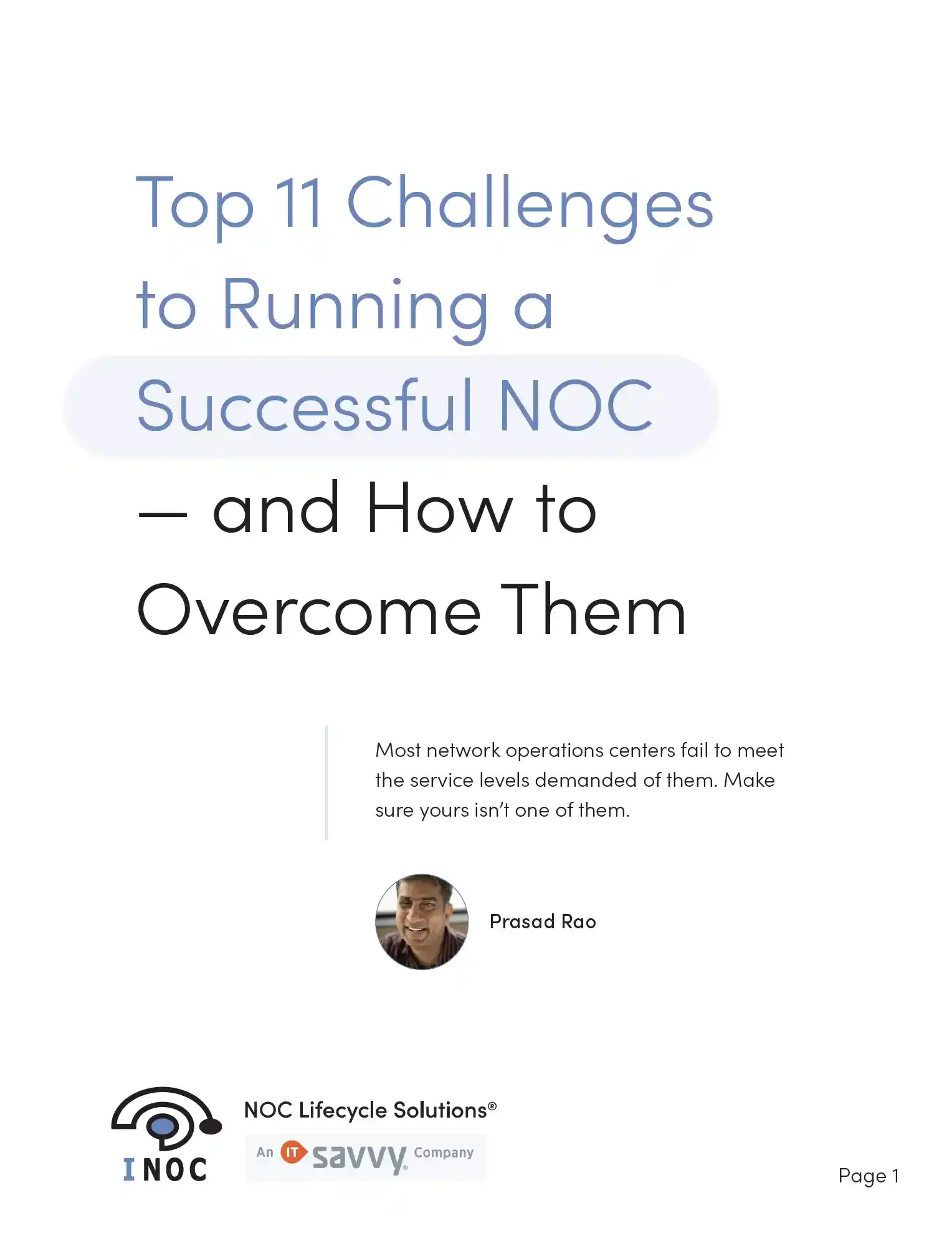
Free white paper Top 11 Challenges to Running a Successful NOC — and How to Solve Them
Download our free white paper and learn how to overcome the top challenges in running a successful NOC.







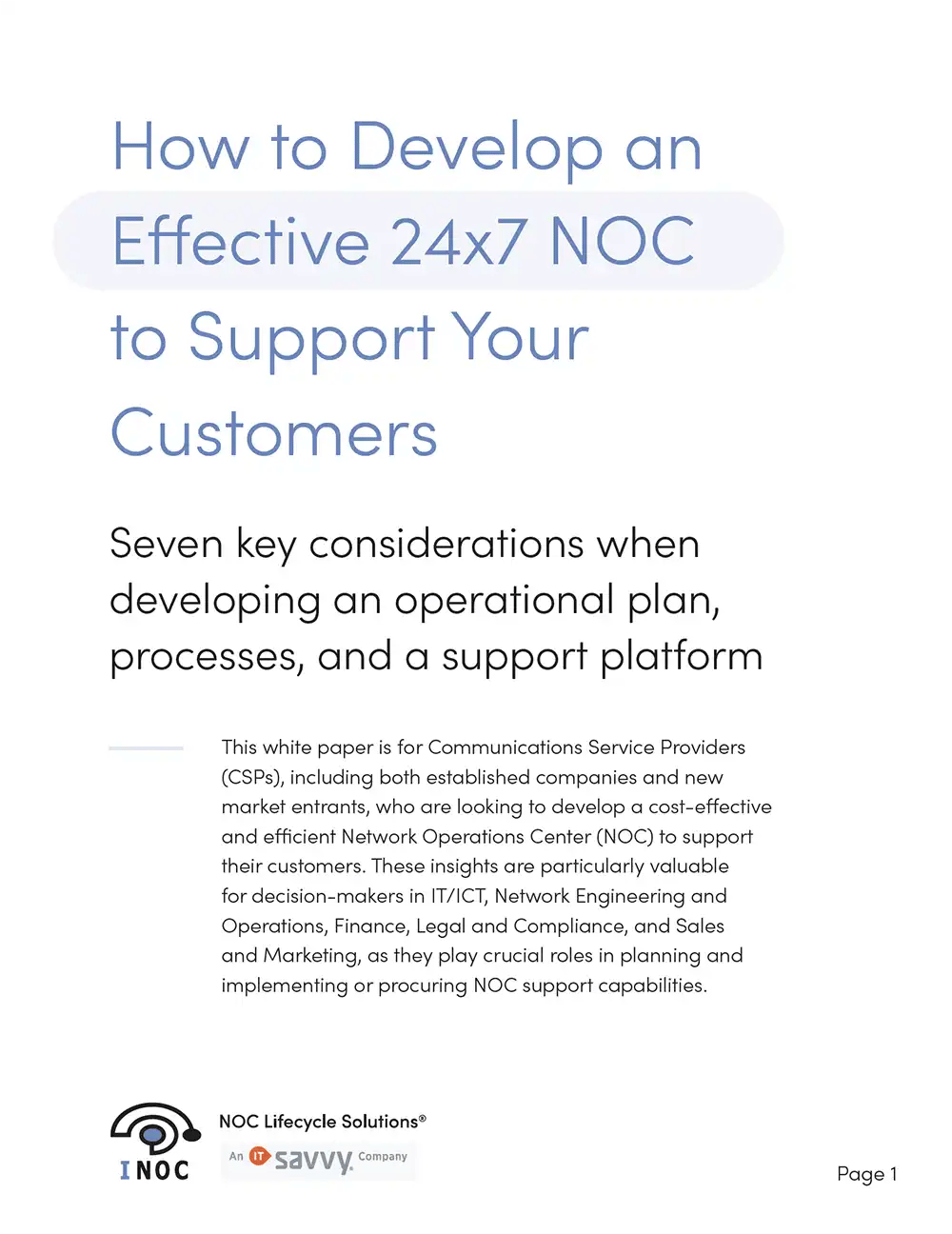

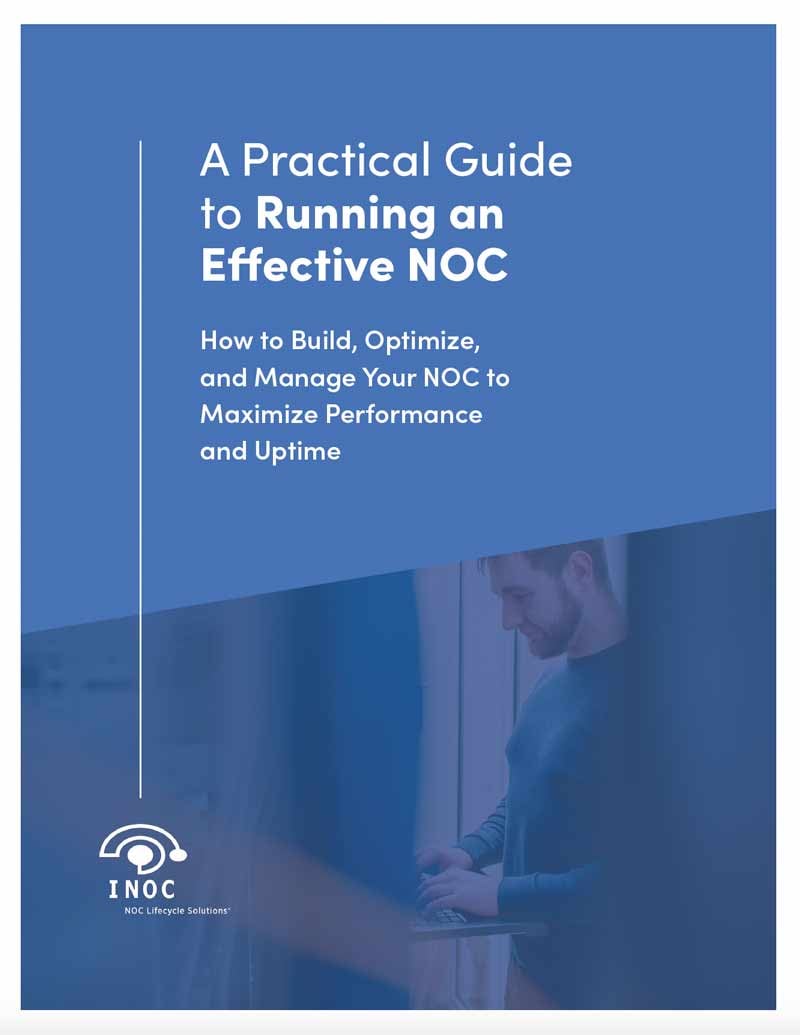
-images-0.jpg?height=2000&name=ino-WP-NOCPerformanceMetrics-01%20(1)-images-0.jpg)



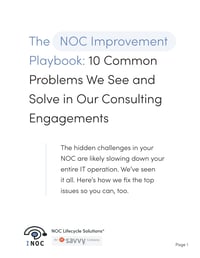
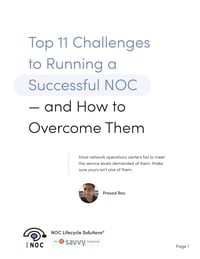
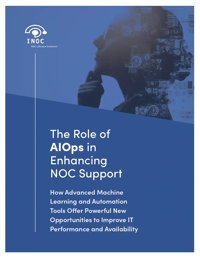
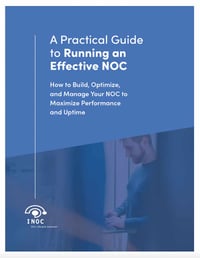
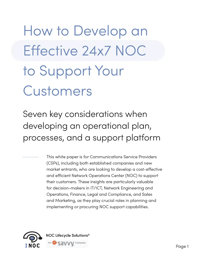
-images-0.jpg?width=200&height=259&name=ino-WP-NOCPerformanceMetrics-01%20(1)-images-0.jpg)